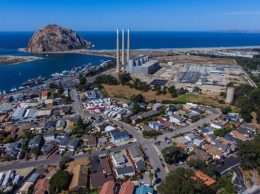UTC takeover looms for Clipper Windpower
IN THIS ARTICLE
- Technology Topic
- Stephen Nellis Author
By Stephen Nellis Monday, October 11th, 2010
After rocky sales timing put Clipper Windpower in a cash crunch, its largest investor is in position to take control of the Carpinteria company just as its long-term prospects brighten.
In December, multinational conglomerate United Technologies Corp. acquired a 49.5 percent stake in Clipper in a transaction that pumped $206 million in new capital into the turbine maker, whose shares trade on the Alternative Investment Market of the London Stock Exchange.
The investment included a “standstill provision” that said UTC couldn’t boost its holdings — and take control of Clipper — for at least two years. But it also included a provision that gave UTC the right to boost its stake to 55 percent if Clipper burned through 75 percent or more of UTC’s investment before 2012.
“There was a calculation they performed that indicated we had reached that milestone,” Michael Keane, Clipper’s chief financial officer, told the Business Times. “Whether they exercise that right or not is up to them.”
A UTC spokesman did not return requests for comment by press time.
Clipper said its unrestricted cash position was $139.9 million at June 30, but that total dropped to about $85 million by the end of September.
In some ways, the cash crunch is a positive sign for Clipper — it spent $55 million in less than three months buying up turbine parts to fill orders, according to company officials. The company is the fastest-growing in the Tri-Counties, according to the Business Times’ annual survey, which ranks companies by three-year revenue growth. Clipper’s revenues grew by more than 3,000 percent between 2007 and 2009.
But the timing of Clipper’s revenue in 2010, combined with its flurry of spending, could allow UTC to take control of the company far ahead of its original schedule.
Meanwhile, Clipper needs new cash to stay in business. Without access to capital, the company said in filings, “the current business circumstances create a material uncertainty that casts significant doubt on the [Clipper’s] ability to continue as a going concern.”
Clipper said it’s in talks with UTC for new financing, either in the form of credit support or selling stock. During the talks, Clipper said, UTC said it was interested in buying all of the Clipper shares it doesn’t already own.
The possible change in control at Clipper comes at a time when the company’s leaders are optimistic about its future. After it began making turbines at its plant in Iowa, the 770-employee firm suffered a blow when cracks in its blades led to a remediation program that cost it hundreds of millions of dollars.
Big machines like Clipper’s 2.5-megwatt Liberty turbine cost millions and are designed to last for decades, and the blade problems shook the market’s confidence in the young company. The big benefit in the investment from UTC was the perception that Clipper’s machines had the backing of one of a global industrial powerhouse. That backing was made explicit earlier this year when UTC agreed to provide warranty support for Clipper’s turbines.
Combined with some technology-sharing agreements and backing from UTC’s sales force, “this is a significant game changer for us,” Mauricio Quintana, the UTC veteran who took over as Clipper’s CEO in March, told investors during a conference call.
Clipper says it has about 4.5 gigawatts — about 1,800 of its Liberty turbines — in its sales proposal pipeline, including about 1.8 gigawatts in later-stage talks.
“Fifty-four percent of that pipeline represents opportunities outside of the U.S. That’s a sea change for Clipper,” Keane said. “We have the ability now to compete on a level with tier-one turbine suppliers,” such as General Electric, one of UTC’s rivals in many markets.
For the first half of the year, Clipper’s net loss was $26.7 million, compared with $120.2 million in the first half of last year. One big difference was revenue. It was $154 million on 43 turbines in the first half of 2010, compared to $357.3 million from 127 turbines in the first six months of 2009.
Clipper said it expects two-thirds of its sales to come in the second half of this year. But while Clipper gets payments from customers as it’s building turbines for them, the company generally doesn’t book revenue until a machine is delivered. It has had to dig deep into its cash in recent months to buy parts.
“We were starting to ramp up production. We were also ramping up our procurement of components. So it’s not a straight line,” Keane said of Clipper’s recent costs.
One deal Clipper is hoping to replicate as it moves into new markets is the $81 million financing granted last year by the Export-Import Bank of the United States to a Mexican wind project using Clipper’s turbines.
“We have sufficient U.S. content to be able to qualify for that Ex-Im financing, and Ex-Im Bank has expressed a desire for more opportunities to finance Clipper Liberty turbines outside the U.S.,” Keane said. “That’s a very important sales tool for us. It helps differentiate us from our competition.”
Are you a subscriber? If not, sign up today for a four-week FREE trial or subscribe and receive the Book of Lists free with your purchase.











